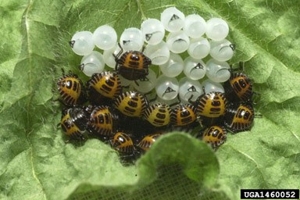Halyomorpha halys (Stål)

The brown marmorated stink bug is a non-native insect introduced from Asia. It was first identified in the United States in Allentown, Pennsylvania in 1998. Since then, it has multiplied and spread throughout the Middle Atlantic states, into the Midwest, and has also been confirmed in California, Oregon and Washington on the west coast. It is a strong flier and spreads easily and feeds on a very broad number of host plants. Damage has been severe in some areas and this insect is currently expanding into the northeast and other areas. As of spring 2011, it had been confirmed in Connecticut in all but one county.
This stink bug is most significant because of its potential to damage agricultural and ornamental plants. It is also a nuisance pest, congregating on structures in the fall looking for protected overwintering sites, often in large numbers. These bugs may accidentally end up indoors, much like the Asian ladybeetle, the western conifer seed bug or the boxelder bug. Like other stink bugs, it produces an unpleasant odor when threatened. The odor is produced by chemicals called aldehydes released from glands on the thorax.
Stink bugs are true bugs in the order Hemiptera, which means they undergo incomplete metamorphosis. When the young hatch into nymphs, they already somewhat resemble the adult,

unlike complete metamorphosis as seen in beetles, moths and butterflies. The nymphs do have more striking coloration than the adults, having a yellowish background mottled with black and red. The nymphs molt five times, gradually increasing in size and changing form and color until they become adults. Newly hatched nymphs are 2.4mm long and adults are about 17mm long. Adults are brown and mottled in appearance. Key features for identification include alternating dark and light bands on the antennae and on the edges of the abdomen.
The term ‘marmorated’ means ‘having a marbled, veined or streaked appearance’. The overwintering adults will emerge in late April to mid-May, then mate and lay eggs from May through August. Eggs are laid on the undersides of leaves in clusters of 20-30 and are variable in color, barrel shaped, and 1.6 x 1.3mm in size. They have rows of tiny, fine spines on the surface. Adult females can lay up to 250 eggs in a season.There is probably one generation per year in the northeast. During late September and October, the adults begin searching for overwintering sites, often congregating in large numbers on buildings.
This insect has the potential to cause significant damage to its known host plants.
High risk: Apple, Asian pear, Beans (green, pole, snap), blackberries, cherry, edamame, eggplant, European pear, grape, hazelnut, Japanese pagoda tree, nectarine, okra, peach, pear, pepper, raspberries, redbud, sweet corn, Swiss chard, and tomato.
Moderate risk: apricot, asparagus, blueberry, broccoli, cauliflower, cherry, collard, cucumber, flowering dogwood, horseradish, lima bean, littleleaf linden, serviceberry, and tomatillo.
Low risk: blackgum, carrot, cranberries, garlic, ginkgo, greens, Japanese maple, kohlrabi, Kousa dogwood, leeks, lettuce, maple, onion, potato, spinach, sweet potato, and turnip.
Stink bugs feed on plant tissue by piercing the cells and sucking out the contents. This results in symptoms including fruit distortion, discoloration, necrotic (dead) spots, and internal rot of the fruits at the feeding sites.

Research is ongoing to determine effective management and control for this pest on its plant hosts. Many products, especially some of the newer, more environmentally friendly insecticides and repellants, do not seem very effective against this insect. Products containing pyrethrins labeled for stink bugs in general may offer some control if damaging populations occur. For current information for commercial fruit growers visit the CT IPM Fruit Pest Messages page.
Control of the brown marmorated stink bug in homes consists of preventing entry and removal of insects using a vacuum cleaner. To prevent entry, seal all cracks and openings around windows, doors, siding, pipes, chimneys and other openings with caulk. Repair any tears or holes in screens. Once stink bugs are present in the home, they can be removed using a vacuum cleaner and disposing of the bag to avoid a lingering odor. They can also be drowned in a bucket of soapy water. Exterior applications of insecticides labeled for this purpose may offer minor relief, but the effect may be short-lived because some insecticides are broken down chemically by sunlight. Application should be done in the fall prior to bug congregation. Indoor insecticides are not recommended. Whenever using pesticides read and follow all label instructions carefully.
Pesticide Safety Tips. READ THE LABEL on each pesticide container before each use. Apply as directed. Heed all warnings and precautions. Store pesticides in their original labeled containers out of reach of children, irresponsible people and pets, preferable under lock and key. Dispose of empty containers safely.
Despite good cultural practices, pests and diseases at times may appear. Chemical control should be used only after all other methods have failed. For pesticide information please call UConn Home and Garden Education Center or your local cooperative extension office.
The UConn Home & Garden Education Center supports UConn Extension’s mission by providing answers you can trust with research-based information and resources. For gardening questions, contact us toll-free at (877) 486-6271, visit our website at homegarden.cahnr.uconn.edu, or reach out to your local UConn Extension center at cahnr.uconn.edu/extension/locations.
Written by Joan Allen. Revised by the UConn Home and Garden Education Center, 2016.